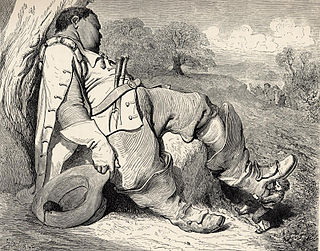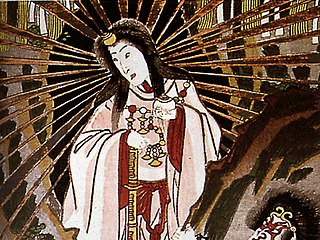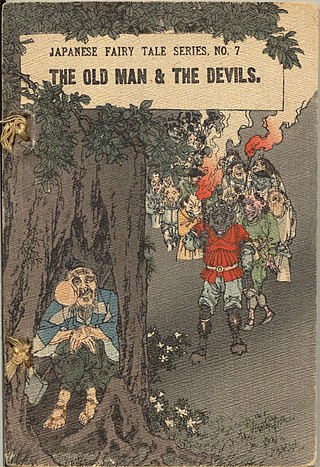Related Research Articles
Japanese folktales are an important cultural aspect of Japan. In commonplace usage, they signify a certain set of well-known classic tales, with a vague distinction of whether they fit the rigorous definition of "folktale" or not among various types of folklore. The admixed impostors are literate written pieces, dating back to the Muromachi period or even earlier times in the Middle Ages. These would not normally qualify for the English description "folktales".

Kunio Yanagita was a Japanese author, scholar, and folklorist. He began his career as a bureaucrat, but developed an interest in rural Japan and its folk traditions. This led to a change in his career. His pursuit of this led to his eventual establishment of Japanese native folkloristics, or minzokugaku, as an academic field in Japan. As a result, he is often considered to be the father of modern Japanese folklore studies.

In traditional Japanese folklore a kappa—also known as kawatarō, komahiki, with a boss called kawatora or suiko—is a reptiloid kami with similarities to yōkai. Kappa can become harmful when not respected as gods. Accounts typically depict them as green, human-like beings with webbed hands and feet and turtle-like carapaces on their backs. A depression on the head, called a "dish", retains water, and if this is damaged or its liquid is lost, a kappa becomes severely weakened.

Seven-league boots are an element in European folklore. The boots allow the person wearing them to take strides of seven leagues per step, resulting in great speed. The boots are often presented by a magical character to the protagonist to aid in the completion of a significant task. From the context of English language, "Seven-league boots" originally arose as a translation from the French bottes de sept lieues, popularised by Charles Perrault's fairy tales.

Bunbuku Chagama, literally "Bunbuku tea-kettle" is a Japanese folktale or fairy tale about a tanuki, that uses its shapeshifting powers to reward its rescuer for his kindness.
The Amanojaku or Amanjaku is a demon-like creature in Japanese folklore.

Tikki Tikki Tembo is a 1968 picture book written by Arlene Mosel and illustrated by Blair Lent. The book tells the story of a Chinese boy with a long name who falls into a well. It is an origin myth story about why Chinese names are so short today.

Shita-kiri Suzume, translated literally into "Tongue-Cut Sparrow", is a traditional Japanese fable telling of a kind old man, his avaricious wife and an injured sparrow. The story explores the effects of greed, friendship and jealousy on the characters.
Why the Sea Is Salt is a Norwegian fairy tale collected by Peter Christen Asbjørnsen and Jørgen Moe in their Norske Folkeeventyr. Andrew Lang included it in The Blue Fairy Book (1889).
Keigo Seki was a Japanese folklorist. He joined a group under Yanagita Kunio, but often came to different conclusions regarding the same folktales. Along with collecting and compiling folktales, Seki also arranged them into a series of categories.

Japanese folklore encompasses the informally learned folk traditions of Japan and the Japanese people as expressed in its oral traditions, customs, and material culture.

Tsuru no Ongaeshi is a story from Japanese folklore about a crane who returns a favor to a man. A variant of the story where a man marries the crane that returns the favor is known as Tsuru Nyōbō.

"Kobutori Jiisan" translated directly as "Lump-Taken Old Man" is a Japanese Folktale about an old man who had his lump taken or removed by demons after joining a party of demons (oni) celebrating and dancing in the night.
Kōga Saburō (甲賀三郎) is a character in Japanese folklore associated with the Suwa region.
The Calumniated Wife is a motif in traditional narratives, numbered K2110.1 in Stith Thompson's Motif-Index of Folk-Literature. It entails a wife being falsely accused of, and often punished for, some crime or sin. This motif is at the centre of a number of traditional plots, being associated with tale-types 705–712 in the Aarne–Thompson–Uther Index of tale-types.

Hachikazuki or Hachi Katsugi is a Japanese folktale of the Otogi-zōshi genre. It refers to a maiden of noble birth who wears a bowl on her head and marries a prince.
The Fire Boy is a Japanese folktale collected by scholar Seki Keigo. It tells of a boy expelled from home to another realm and, thanks to the efforts of a faithful horse, marries a lord's daughter.
The Snail Son is a character that appears in Japanese folktales, as a type of enchanted husband that becomes disenchanted from his animal form and becomes a handsome man. Some tales are related to the cycle of Animal as Bridegroom or The Search for the Lost Husband.
The Golden Eggplant is a Japanese folktale, published by scholar Seki Keigo in Folktales of Japan. Scholars relate it to tale type ATU 707, "The Three Golden Children", of the international Aarne-Thompson-Uther Index.
Fanny Alice Hagin Mayer was an American folklorist, translator, and educator. Her work focused on Japanese folktales.
References
- 1 2 Yamazato 1983 , p. 146.
- ↑ Kunio 1986 , p. 5.
- ↑ Bonnin 2003 , p. 41
- ↑ King & Fraser 2019 , p. 107-108.
- ↑ Goldberg 1997 , p. 37
- ↑ Eder 1969 , p. 24.
- ↑ Seki 1966 , p. 84-85.
- ↑ Kunio 1986 , p. 5-8.
- ↑ Seki 1966 , p. 85.
- ↑ Fujii 2013 , p. 18
- ↑ Kunio 1986 , p. 6-8.
- ↑ Hiroko Ikeda. A Type and Motif Index of Japanese Folk-Literature . Folklore Fellows Communications Vol. 209. Helsinki: Suomalainen Tiedeakatemia. 1971. p. 100.
- ↑ Mayer 1974 , p. 78.
- ↑ Kunio 1986 , p. 8.
- ↑ Takagi 2013.
- ↑ Takagi 2013 , p. 51.
- ↑ Hiroko Ikeda. A Type and Motif Index of Japanese Folk-Literature . Folklore Fellows Communications Vol. 209. Helsinki: Suomalainen Tiedeakatemia. 1971. p. 100.
- ↑ Nakawaki 2020 , p. 165 n.22.
- ↑ Goldberg 1997 , p. 36-37.
- ↑ Mayer 1960 , p. 665-666.
- ↑ Mayer 1960 , p. 666.